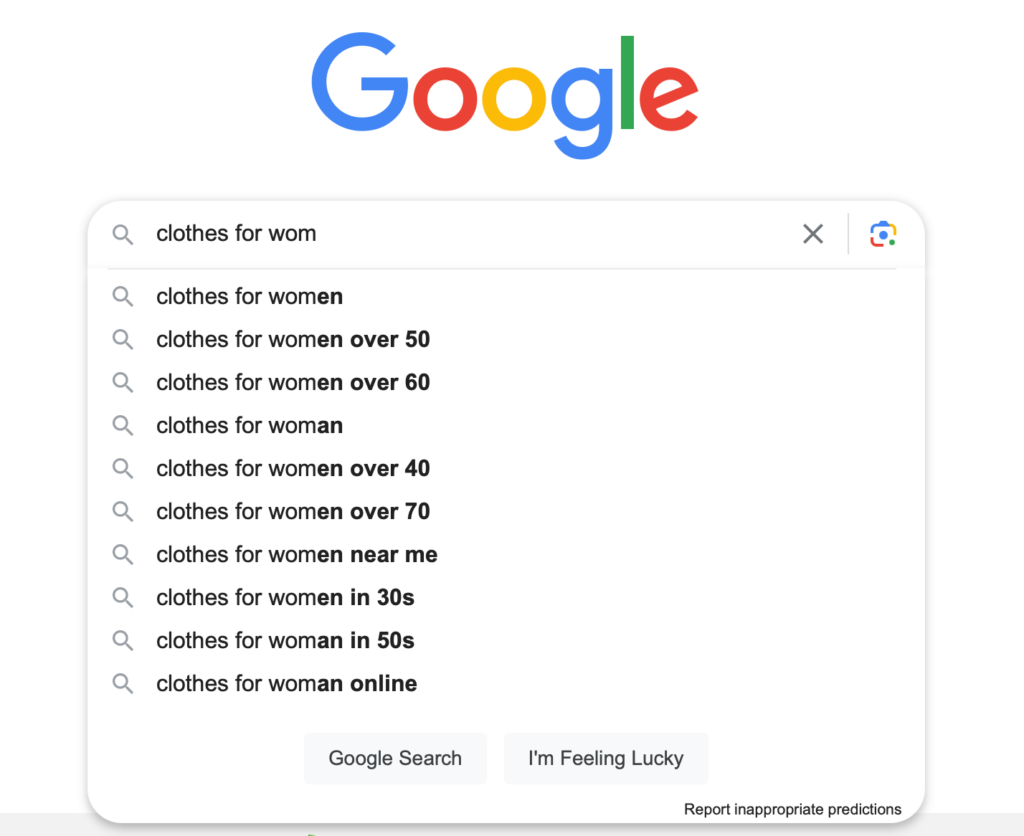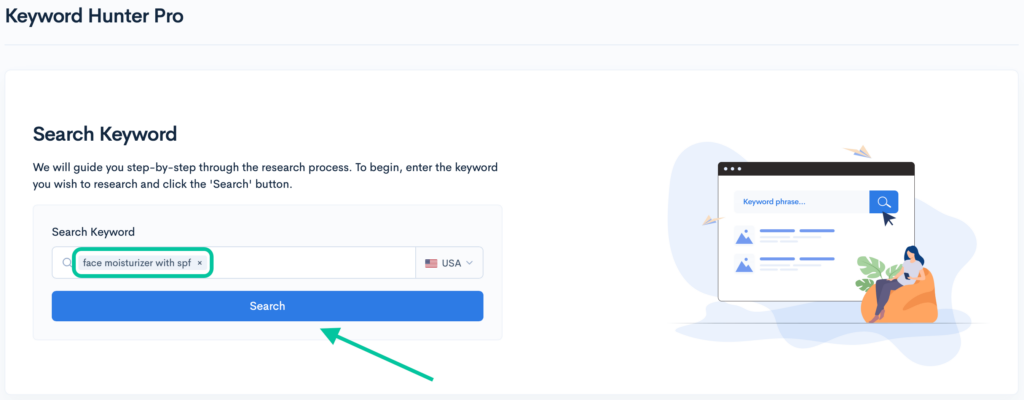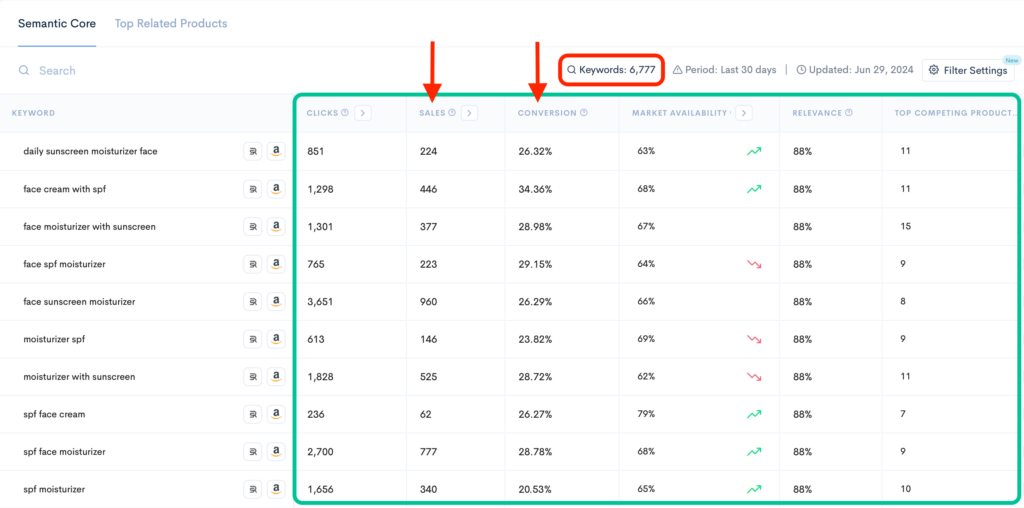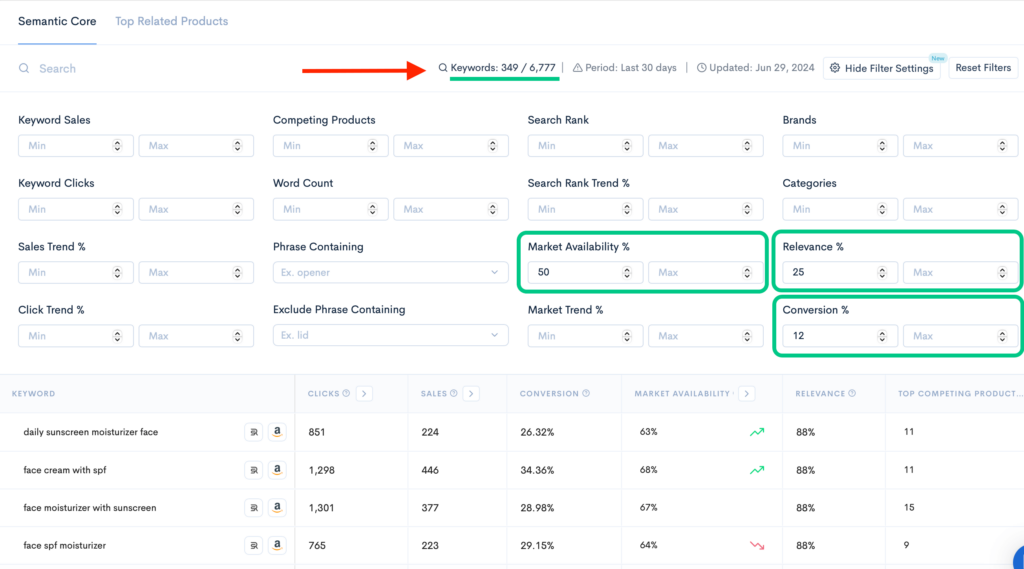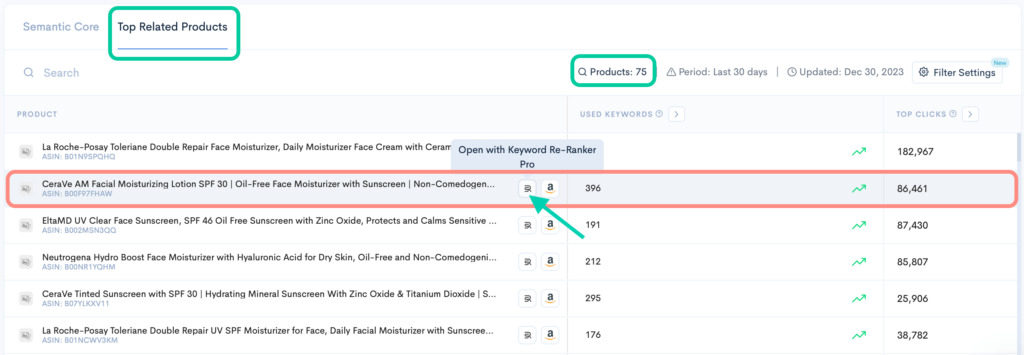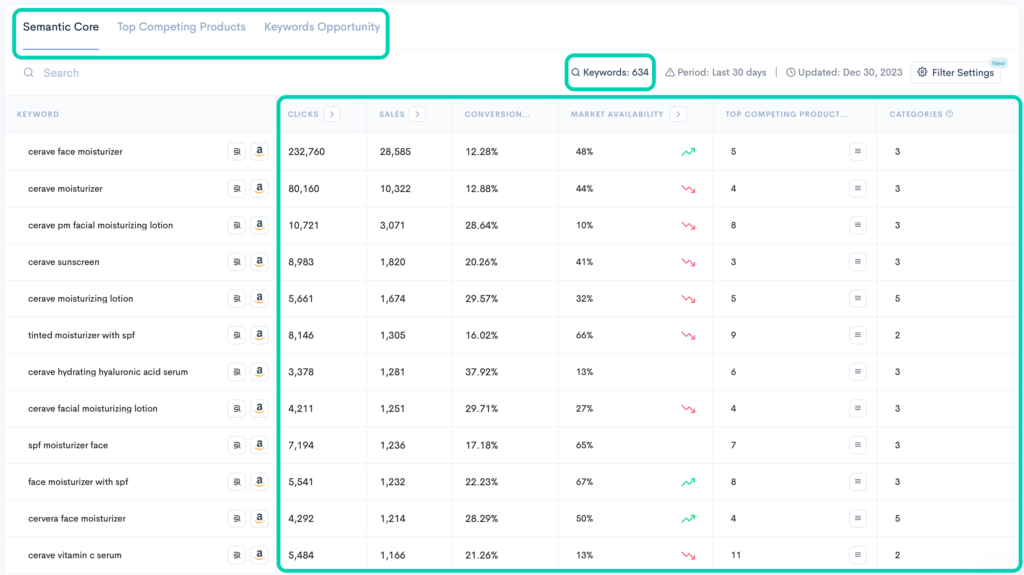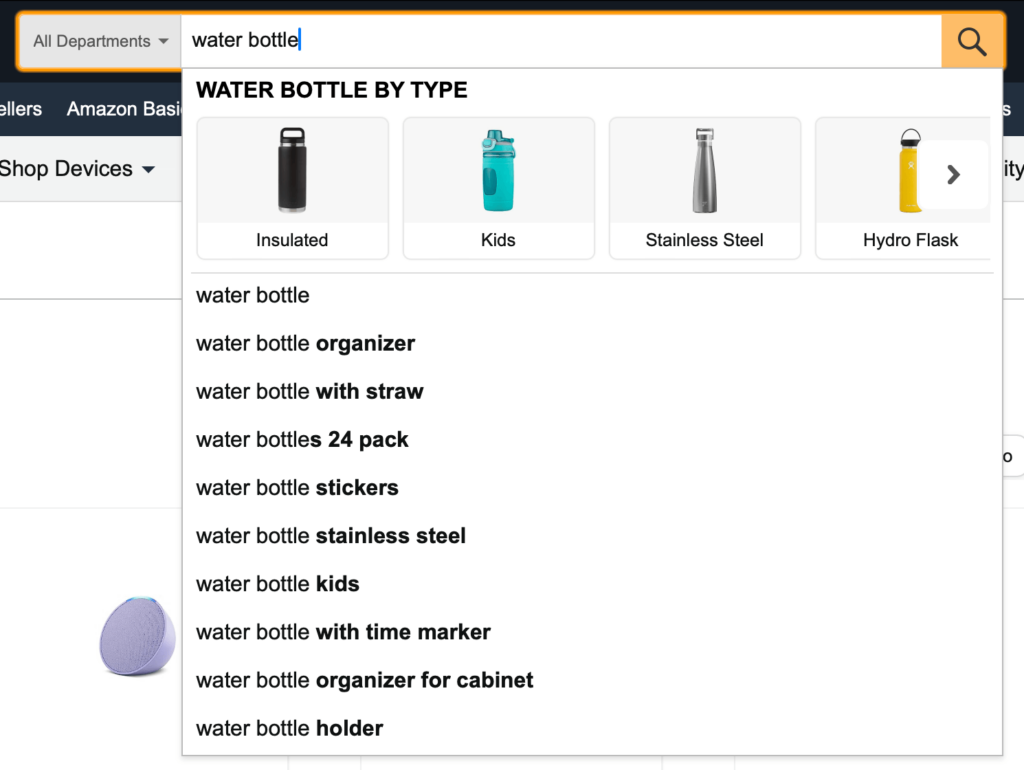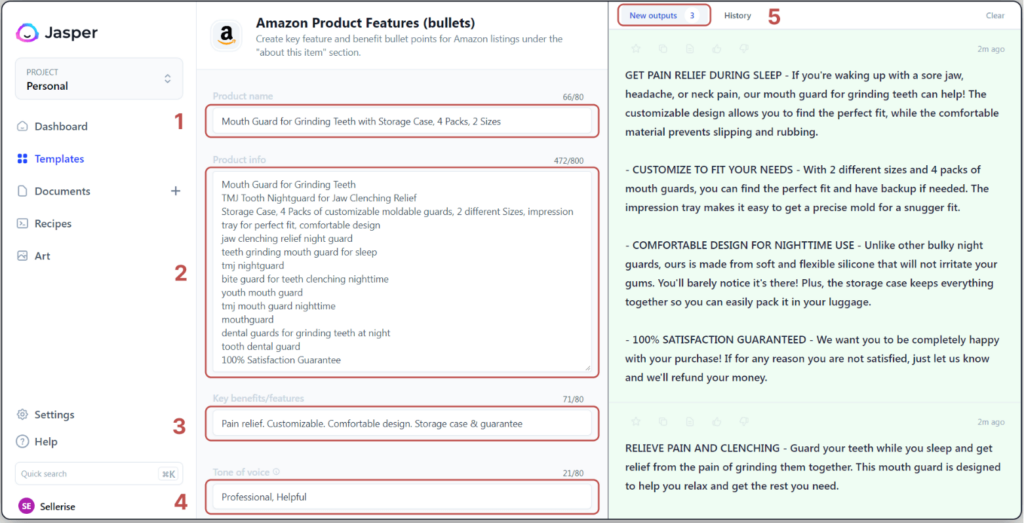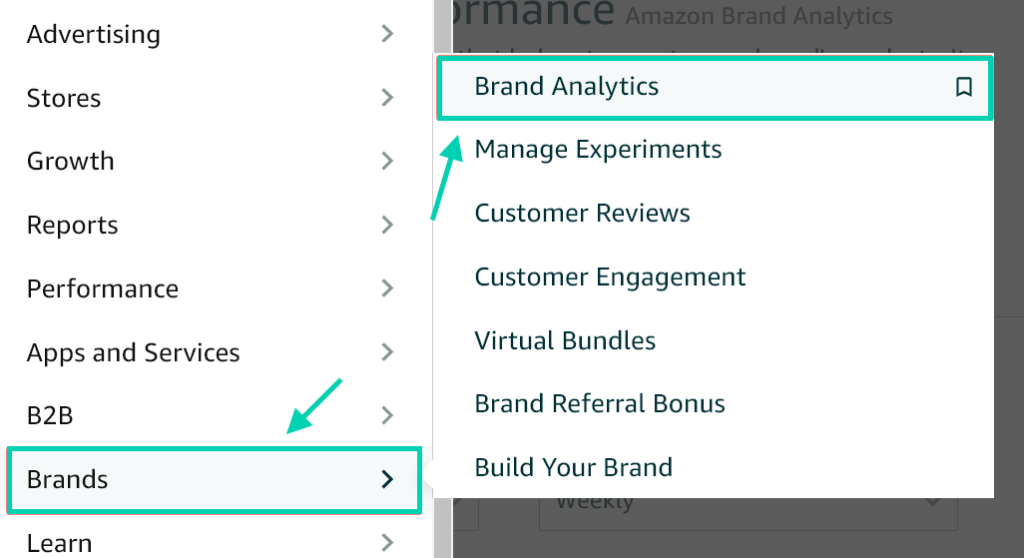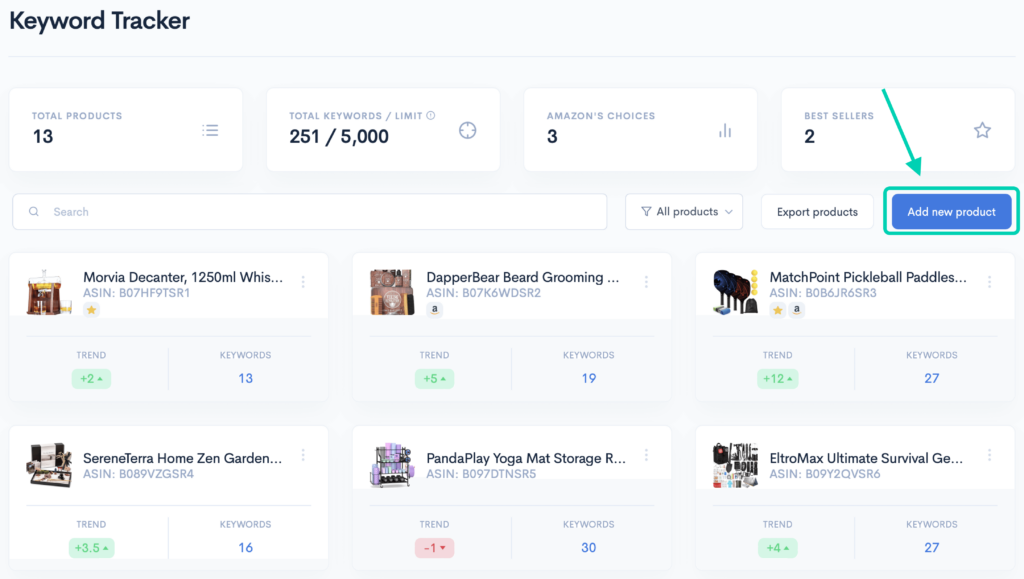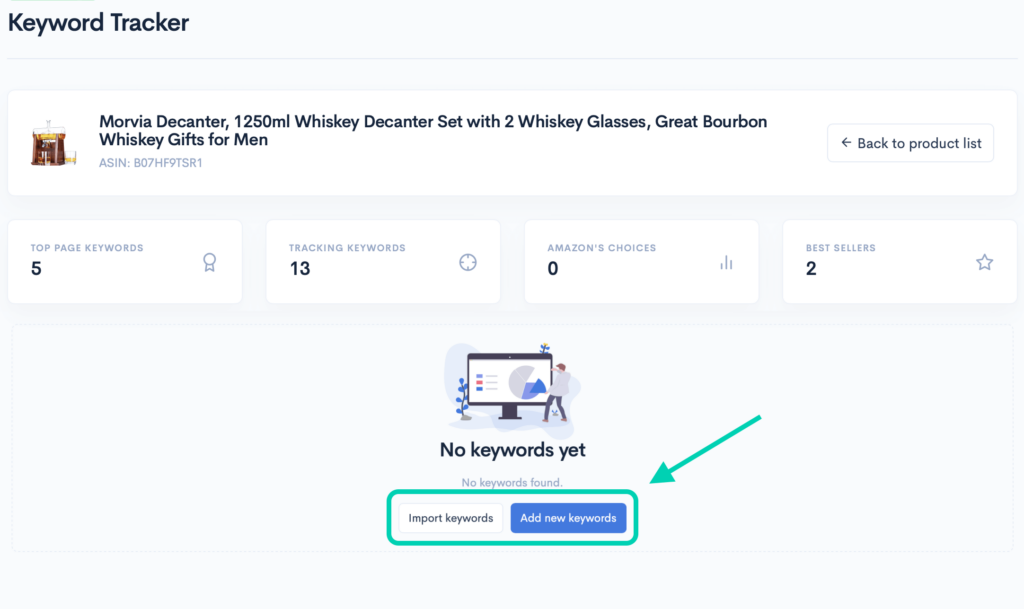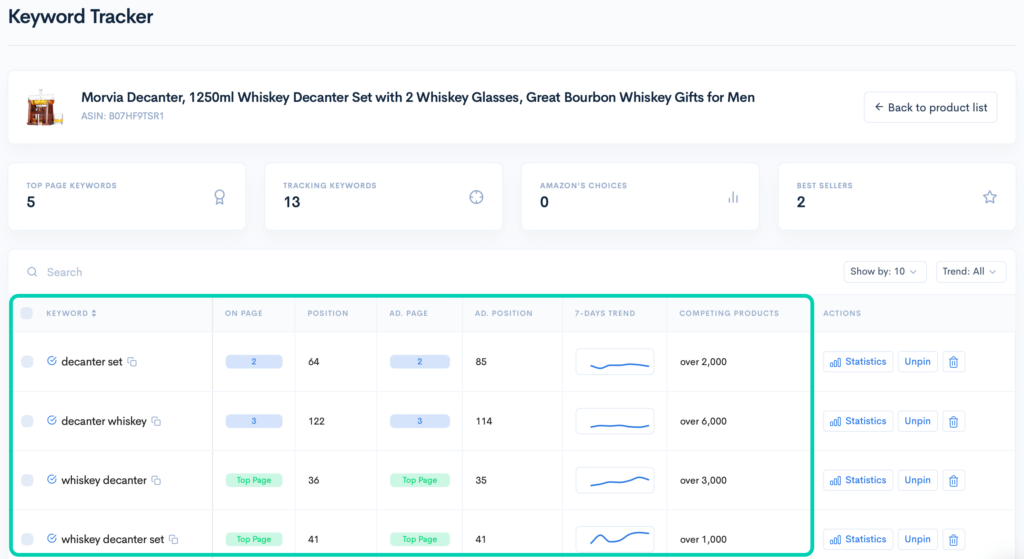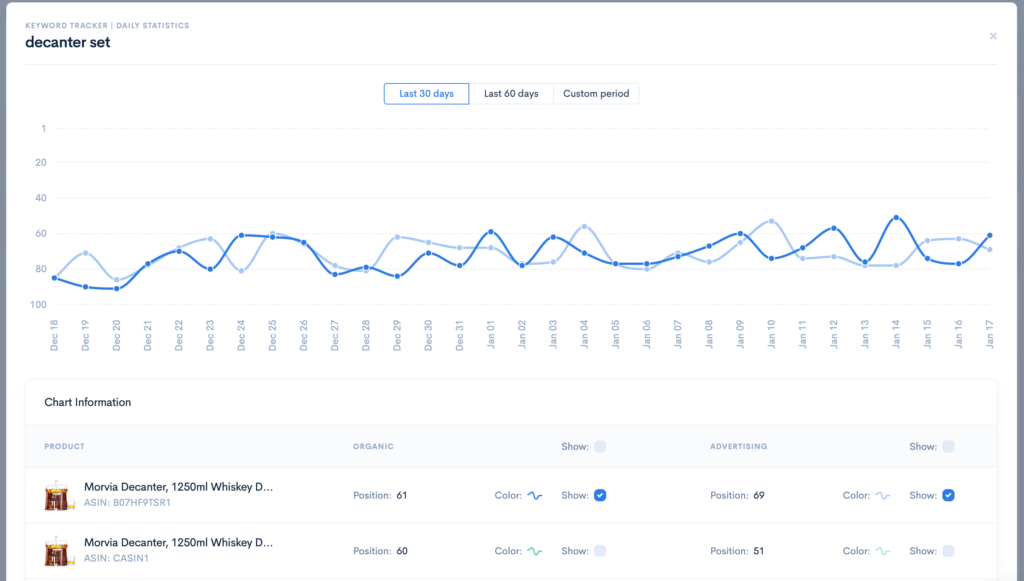Amazon Keyword Research Strategies: 6 Best Methods
Keren Dinkin, Copywriter
14 min read -
Updated:Amazon is definitively among the leading ecommerce platforms when it comes to global reach. It’s a digital destination where sellers can reliably find buyers for their products, whatever their niche may be.
It’s such a busy marketplace for small- and medium-sized businesses (SMBs) that over 60% of all units sold on Amazon in the third quarter of 2023 came from third-party sellers like yourself. Your ecommerce business can experience significant growth if you learn how to convert your audience on Amazon.
One of the simplest ways to boost your performance is by conducting effective Amazon keyword research to optimize your product listings. This guide has all you need to know.
Why Keyword Research Is Important for Amazon Sellers
Amazon is a massive, global online marketplace, and there are millions of active sellers on the platform. This means your business is going up against hundreds, if not thousands, of competitors in your chosen niche. Their products will likely have similar features and be priced in the same range to draw customers.
You will be running neck-and-neck with your competitors for the same demographics. This begs the question: how can you entice Amazon shoppers to choose your items from the crowd of near-identical ones on their search results pages?
The answer: By employing some savvy Amazon keyword research strategies that will propel your product listing to the top of the search results. To do so, you’ll need to understand how keywords on Amazon work and all the ways you can leverage them to your advantage.
Before we dive into those topics, let’s look at Amazon keywords and why they are important.
Get More Eyes on Your Products with Keyword Research
Amazon isn’t just an ecommerce platform; it’s also a powerful search engine for online shopping. When people want to read up on a new product or service, they go to Google. And when they are ready to purchase, they come to Amazon.
Two-thirds (66%) of shoppers surveyed in 2019 said they typically start their search for new products on Amazon. An overwhelming majority of them (95%) are satisfied with their Amazon search results. This highlights the importance of using the best Amazon keywords to improve your products’ search engine results page (SERP) ranking and deliver them to eager shoppers.
How often do you click to the second or third page of search results on Amazon, Google, or any other search engine? It’s human nature to focus on the immediate information we receive, which is reflected in Amazon shoppers’ behavior.
A consumer trends survey of over 1,000 customers conducted in the last quarter of 2023 found that 73% of online shoppers click on the very first listing in their search results. That number drops drastically to 14% for the second and 5% for the third. This leaves a paltry 8% for all other listings that follow the top three.
If you want your products to occupy the priceless real estate that is the top listings on Amazon search pages, you need an effective keyword strategy. The platform’s algorithm uses these words or phrases to index product listings according to their relevance to shoppers’ search queries.
For sellers, there are three areas in which you must strategically leverage keywords:
- Product title: The keywords in the product title will be the first ones potential customers see in the search results. They should be very descriptive and match what the shopper is looking for.
- Product pages: You can organically work in more related keywords in the bullet points and product description sections on each product listing.
- Seller central back-end: Amazon allows sellers to include hidden keywords on the back-end of their product pages, which will give the A9 algorithm added context when it indexes the item according to relevance.
Using a well-researched combination of different keyword types for your product listings will help you gain a broader audience on Amazon and increase your brand’s reach.
Top 5 Benefits of Amazon Keyword Research
Amazon keywords will help get your product listings to the top of the platform’s search results. That alone is a good enough reason to carefully consider your keyword research strategy. However, the increase in exposure also brings additional benefits for your business in the long run.
Here’s how keyword research can add value to your ecommerce business:
1. Boosts Sales Numbers
The most obvious advantage of a robust keyword strategy is that more eyes on your products will lead to more sales. Using the right keywords will draw thousands of interested buyers to your product and your brand storefront.
The more relevant your product is to their search, the better the odds that they will complete a purchase.
2. Better Audience Engagement
Carrying out effective keyword research will help you discover what your audience is looking for. With this data, you can further optimize your product listings to match their search intent. This will increase interest in your store and raise your brand’s profile.
3. Attracts Qualified Traffic
Choosing keywords that rank for relevant search terms is how you access the precise demographics that are ripe for conversion. These customers are actively looking for your products. All that remains is for you to tailor your content to convince them to choose your store over your competitors.
4. In-Depth Insights into Trends
Keyword research gives you a unique perspective on consumer intent and market trends. With cutting-edge keyword tracking tools, you can identify high-performing keywords and adjust your strategy accordingly.
5. Higher Organic Rankings
Keywords aren’t the only deciding factor for where your product appears in Amazon’s SERP. Customer reviews, number of sales, and seller metrics also impact the Amazon A9 algorithm.
But once you’ve put a keyword strategy into action, it sets off a chain reaction of events. Better-performing keywords lead to higher rankings, which lead to more sales, which once again raise your listing’s rankings.
More sales means more data to analyze and improve your keyword strategy, and you can continue to reap the benefits of keyword research at every stage of growth.
6 Effective Methods to Conduct Amazon Keyword Research
Are you ready to boost your Amazon sales numbers? Do you wish to stake a claim to your own corner of the world’s favorite online marketplace? With an estimated net sales revenue of nearly $514 billion in a calendar year, Amazon is undoubtedly the place to go if you want to grow your ecommerce business.
You need a sound strategy and the right keyword research tools to take full advantage of the platform. When performing a keyword search for Amazon listings, you must track search volume, trends predicting whether popularity will rise or fall, and the level of keyword difficulty and competition. These metrics will help you choose the best words and phrases to integrate into your product listings.
Let’s take a look at seven proven methods of compiling keywords on Amazon:
1. Create a Core Keywords List
Knowing your consumers is of utmost importance when choosing keywords.
First, prepare a list of search terms that accurately describe your product. For example, if you are selling unisex clothing, your core keyword list might look something like this:
- Unisex clothes
- Clothes for men and women
- Clothes for men
- Clothes for women
- Menswear
- Womenswear
- Gender-neutral clothing
Certain terms are obviously relevant to your listing, and you don’t need advanced research tools to tell you that. Put yourself in the consumer’s shoes. Are these phrases the queries they might enter into the search bar? If the answer is yes, they definitely belong in your core list.
This core list is the seed from which the rest of your keyword strategy will blossom. Don’t worry about search volume, click-through rates (CTR), or conversion rates (CVR) at this early stage of your keyword research. Instead, use these phrases as a starting point for your strategy.
Once you’ve built up a decent bank of exact and long-tail keywords relevant to your product, you can begin to include higher-performing terms.
But, Amazon keyword research is an intricate process, and if you attempt it without any kind of assistance, you won’t get very far. You need to track a lot of data to optimize your keyword strategy, and you will need a powerful keyword research tool to manage the workload.
Sellerise Keyword Hunter Pro is your source of high-quality keywords that deliver excellent returns. You can use it to uncover profitable keywords by tracking Amazon data in real time. Its growing list of over 46+ million keywords will help your products increase their ranking organically.
Here’s how to get keyword list fast:
- Start with a Keyword that Precisely Explains Your Product: Begin with a term highly related to your product. For instance, if you’re selling face moisturizer with spf, your keyword might be “face moisturizer with spf.”
- Analyze Your Keyword List: Get vital data like how many organic clicks and sales every keyword brings on Amazon, its conversion rate, competition level, trends, and many more.
Remember, the more specifically your keyword explains your product, the more chances that it will have a high conversion rate.
- Use Filters to Refine Your Keyword List: You can filter by search rank, competition level, and even word count. This helps in pinpointing long-tail keywords, which are often less competitive and more targeted.
For example, let’s put in the filters:
- Relevance >25%
- Conversion rate >12%
- Market availability >50%
We just narrowed down to 349 highly-performing keywords that not only bring sales, but are less competitive.
If you want to go further with narrowing down your keyword list, easily exclude irrelevant keywords. To ensure your keyword list is highly targeted and relevant, you should exclude certain types of keywords:
- Brand Keywords: Use the filter to exclude brand keywords by inputting well-known brands in your category. For example, exclude keywords containing “CeraVe,” “Neutrogena,” “La Roche-Posay,” etc.
- Other irrelevant keywords: For example, based on our example with ‘face moisturizer with spf’, if your product has an SPF of 50, exclude keywords that mention other SPF levels like 15 or 20, and others. This ensures you are targeting only those searches relevant to your product. Same applies to other keywords that you would like to remove from your semantic core list.
Search for long-tail keywords: Long-tail keywords are specific phrases usually containing three or more words. These keywords tend to have lower search volumes but higher conversion rates because they target a more specific audience.
Let’s set the filter for word count to a minimum of 4 words.
Applying these filters will further refine your list to include long-tail keywords that are more specific and less competitive, potentially increasing your conversion rates.
Download your keyword list: Once you got your perfect keyword list, download. Start using them for your product listings.
This is just one approach to finding keywords. Let’s explore additional methods below.
2. Conduct Competitor Research
You are facing tons of competition on Amazon, but this doesn’t have to be a bad thing. There are nearly two million SMBs active on the platform as third-party sellers. Instead of viewing your fellow sellers as obstacles, take an active interest in their keyword strategies and learn from them.
Looking at the keywords your competitors are ranking for will give you a better understanding of the search terms that are relevant to your niche. It is a valuable resource as you develop your own collection of keywords.
Instead of doing your competitor research manually, use Sellerise Keyword Re-Ranker Pro that turns the focus outward to your direct top competitors. It helps you identify new markets and sales opportunities by analyzing which keyword strategies are working well for your competition. It’s easier than ever to stay ahead of the competition with a tool as powerful as the Keyword Re-Ranker Pro.
Here is how to enhance your keyword research with Keyword Re-Ranker:
- Identify Top Competitors: Look for products similar to yours that rank well on Amazon. Alternatively, you can quickly find your competitors in the ‘Top Related Products’ section of Sellerise Keyword Hunter and begin your competitor keyword research right from there.
- Deep Dive with Keyword Re-Ranker: Once you input your competitors’ ASINs into Keyword Re-Ranker, the tool then reveals a list of top organic keywords your competitor is ranking for, offering insights into their strategies.
- Strategic Keyword Selection: From this list, identify keywords that are relevant to your product but perhaps overlooked by your competitors. These are your opportunities to outperform them. Use filter the way we did with keyword research using Keyword Hunter. This will help you easily remove irrelevant ones.
- Download your Rival Keyword List: Export your keyword findings into Excel file. This data serves as a roadmap for optimizing your product listings, ensuring you stay a step ahead in the ever-competitive Amazon marketplace.
Comprehensive keyword analysis of your competition’s products will reveal even more opportunities for your own growth. When you know what works for them, you can adjust your listing optimization strategies and expand your knowledge about current market dynamics.
Furthermore, monitoring your competition means you will learn from their mistakes and avoid unnecessary head-to-head clashes over your shared audience.
The Sellerise tools combine accurate data, cutting-edge automation, and a smooth user experience. When you use these tools, you will find it much easier to find the best Amazon keywords and grow your business.
3. Use Amazon-Specific SEO
Just because Amazon also functions like a search engine, that doesn’t mean it works the exact same way as Google—Amazon’s A9 algorithm is completely different. Sellers need to meet entirely new requirements for their product listings to rank well.
Despite this, many businesses try to apply a one-size-fits-all approach to their SEO strategies. This overlooks the fact that Google users and Amazon shoppers are driven by contrasting motivations. In general, the former are there to learn, while the latter are there to buy. Their search behavior will reflect this particular mindset.
Imagine a shopper who is planning a dinner party for a large group. They might look up “easy pressure-cooker recipes” on Google as they finalize their menu. Then, they will head to Amazon and look up “[XYZ brand] pressure cooker.” They will peruse their options, read through product descriptions, then choose an item that will suit their needs and purchase it.
Therein lies the difference in SEO for Amazon and standard search engines. You have to account for the buyer’s intent when choosing which keywords to use. Consider what information a potential buyer would look up or want to know before making a purchase, and use those related keywords.
4. Use Amazon Auto-Complete Suggestions
Amazon’s search feature is a powerful tool for conducting keyword research. The site’s auto-suggestions provide valuable insights into popular keywords that shoppers use to search for certain items.
By simply typing a phrase into the Amazon search bar, you will see a list of suggested terms that include your primary keyword. From the options that pop up, choose the ones that are most relevant, add them to your list, and analyze them using a robust keyword research tool.
For example, if your main keyword is “water bottle,” you might see suggested phrases like “water bottle with straw,” “water bottle with filter,” and “water bottle for kids.” These suggestions can give you ideas for other long-tail keywords. You may also discover other niche markets within your product category.
Amazon’s auto-suggest feature can also help you identify seasonal trends and popular search terms during specific times of the year. This can be especially valuable when planning promotions and optimizing your product listings for seasonal events.
5. Create Optimized Product Listings
Optimizing your product listing on Amazon is a cost-effective way to improve your product ranking and attract more traffic to your items. When your product listing contains the right mix of keywords, you can reap large rewards in the long run and push our brand forward.
One of the best ways to optimize your product listing is to use third-party AI tools, such as ChatGPT or Jasper. You can use them to write your entire product listing, from the titles and descriptions to the bullet points. With their highly advanced algorithms, these AI tools will analyze your product and create unique descriptions that use your target keywords and will perform well with Amazon’s algorithm. Just paste your keyword list and let the tools do the work for you.
While you can leverage AI technology to prepare a first draft, you should closely review your product listing before going live. Make sure your each listing follows these established best practices on Amazon:
- The first bullet is the most important. The first words are customer requests or expected results.
- Your bullet points can contain up to 250 characters.
An optimized product listing helps the algorithm understand your product and improve its relevance to the search query. It should also be an ideal landing page to funnel shoppers further down the sales pipeline.
6. Use Keyword Tracking
Your keyword strategy should never be static. Consumer behavior and market trends are constantly changing, and keyword rankings and search volumes evolve along with them. Preparing a list of carefully chosen keywords to use in your listing is only the first step. You need to monitor how shoppers use those keywords and which ones get the most impressions and clicks.
One way to track the performance of your chosen keywords is through Amazon Brand Analytics. This is an invaluable resource for sellers who have signed up through Amazon’s Brand Registry program. The tool provides data on popular search terms, click share, and conversion rates for specific keywords.
With Amazon Brand Analytics, you can gain insights into the top search terms for your product category and the keywords that drive the most sales. You can also monitor your product’s performance and identify opportunities for improvement.
To get started with Amazon Brand Analytics:
- Log in to your Seller Central account
- Navigate to the “Reports” tab
- Select “Brand Analytics” from the dropdown menu to access the tool.
Regularly download reports from Amazon Brand Analytics to adjust your keyword strategies and get the best results even as customer behavior evolves.
Alternatively, you can simplify your keyword rank tracking. Sellerise offers Keyword Tracker that allows you to monitor any keyword (and your competitors) precisely in real time.
Here is how to track keywords with Sellerise Keyword Tracker:
Add your product: Start from adding your product, so we can better monitor keywords.
- Add your keywords: Once you have a refined list of keywords, input these keywords into the Keyword Tracker tool.
- Monitor Keyword Performance Regularly: The Keyword Tracker will provide ongoing data about how each keyword ranks over time. Regular monitoring allows you to see trends, like which keywords are improving in rank and which are declining. This real-time feedback is crucial for adjusting your SEO strategy.
- Stay Ahead of Competition: Keep an eye on how your competitors rank on Amazon. This information can help you identify new opportunities and areas where you need to strengthen your SEO efforts.
Remember, staying ahead in the Amazon marketplace means continuously adapting to changes and using tools like Amazon Brand Analytics and Sellerise Keyword Tracker to refine your keyword strategy. Keep monitoring, stay proactive, and you’ll see your efforts pay off.
Follow the Best Practices for Keyword Compilation
When you use keyword research tools like the ones mentioned above, you will get in-depth insights into which keywords will work best for your products. But the final choice will be made by you and not by any tool, no matter how powerful or accurate they are.
Your aim should be to incorporate as many relevant keywords as you can, but to do so in a natural manner that adds value to the product description. Simply cramming in dozens of keywords to increase their density is known as “keyword stuffing,” and it’s a form of SEO malpractice that is punished by algorithms. You need to stay away from pointless repetition of keywords and avoid falling into this trap.
While on the topic of SEO malpractice, let’s address irrelevant keywords. Some might think it’s a brilliant idea to include a keyword with a high search volume, even if it has nothing to do with the product being sold. For instance, using “flat screen TV” as a keyword for listings that sell furniture items. This unethical keyword usage will lead to a harsh penalty from Amazon, so do not try it.
Here are some other things to keep in mind when compiling your Amazon keywords and writing your product listings:
- Stay away from subjective terms like “best” or “beautiful.” Instead, use descriptive terms that give valuable information to potential customers, such as color and exact size measurements.
- Do not forget to fill out your back-end keywords from Amazon Seller Central. Your product page will benefit from the rankings boost they provide.
Put Your Trust in Advanced Solutions for Keyword Research
Amazon keyword research doesn’t have to be a time-consuming brain drain. Between the reporting features of Amazon Brand Analytics and the advanced insights delivered by keyword search tools, it’s possible to boost your product listings with minimal hassle.
If you are ready to optimize your keyword strategy and transform the way you sell on Amazon, then sign up for a Sellerise demo account today or start your 7-day free trial.

Keren Dinkin, Copywriter
Professional in digital marketing and content creation, with 7 years of experience in the field. Keren has a strong background in e-commerce, helping businesses grow their online presence and achieve their goals.
